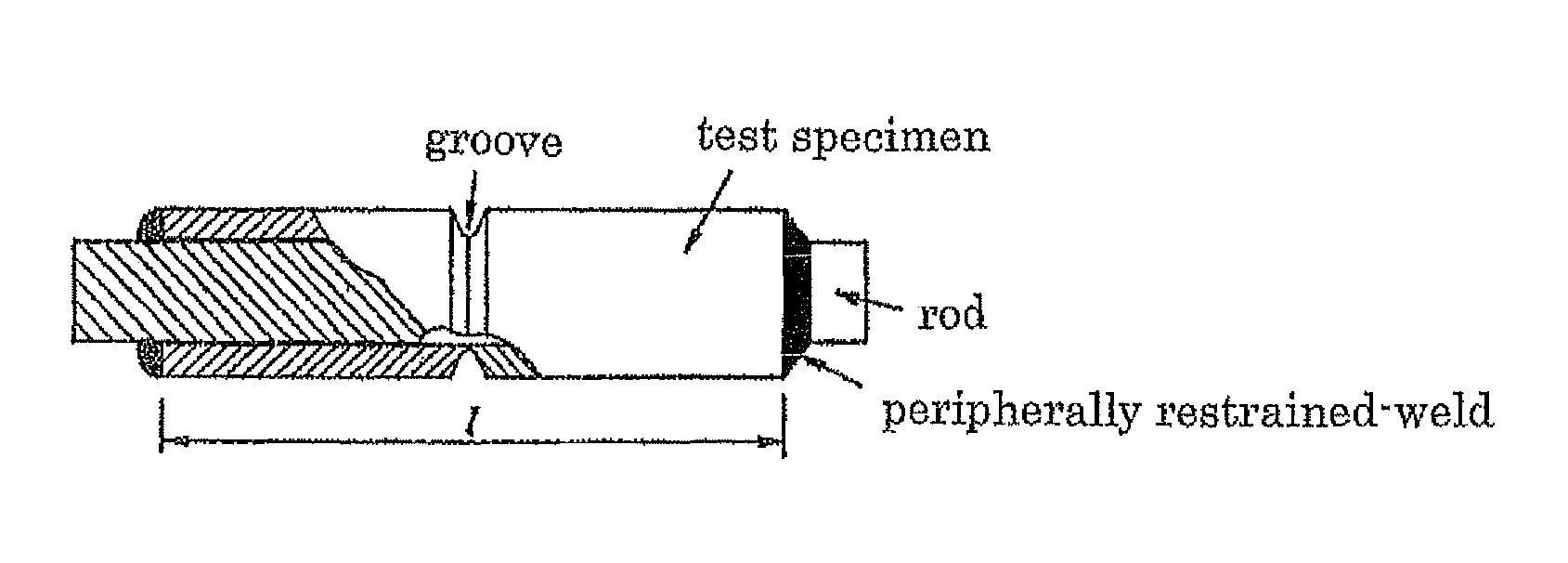Welding material and welded joint structure
a welding joint and material technology, applied in the direction of soldering equipment, heat treatment equipment, furnaces, etc., can solve the problems of increased susceptibility to weld solidification cracking, etc., to achieve excellent weld solidification cracking resistance, excellent high temperature strength and corrosion resistance, and the effect of suppressing weld solidification cracking
- Summary
- Abstract
- Description
- Claims
- Application Information
AI Technical Summary
Benefits of technology
Problems solved by technology
Method used
Image
Examples
example 1
[0249]Austenitic alloys A to E, having the chemical compositions shown in Table 1, were melted using a high frequency induction vacuum furnace and then cast to form ingots for use as base metals.
[0250]Both of the alloys A and E shown in Table 1 are austenitic alloys having the P content as high as 0.100%. On the other hand, the alloys B to D are ordinary P content level austenitic alloys respectively having the P contents of 0.015%, 0.030% and 0.018%.
[0251]
TABLE 1Chemical composition (% by mass) The balance: Fe and impuritiesAlloyCSiMnPSCrNisol. AlNOthersA0.100.200.600.1000.000518.128.860.0260.009Cu: 0.29, Nb: 0.21, Ti: 0.19B0.060.421.180.0150.001025.0719.900.0210.250Nb: 0.44, B: 0.0018C0.100.270.800.0300.000218.109.300.0250.094Cu: 2.95, Nb: 0.42, Mo: 0.16D0.080.220.600.0180.000422.3020.410.0220.012—E0.390.210.820.1000.000429.6449.560.0130.011—
[0252]Austenitic alloys F to H, having the chemical compositions shown in Table 2, were melted using a high frequency induction vacuum furnac...
example 2
[0269]Austenitic alloys D, E and I to L, having the chemical compositions shown in Table 5, were melted using a high frequency induction vacuum furnace and then cast to form ingots for use as base metals. In Table 5, the alloys D and E are the same alloys as melted in the above-mentioned “Example 1”.
[0270]Both of the alloys E and I shown in Table 5 are austenitic alloys having the P content as high as 0.100%. On the other hand, the alloys D and J to L are ordinary P content level austenitic alloys respectively having the contents of P 0.018%, 0.010%, 0.015% and 0.028%.
[0271]
TABLE 5Chemical composition (% by mass) The balance: Fe and impuritiesAlloyCSiMnPSCrNisol. AlNOthersD0.080.220.600.0180.000422.3020.410.0220.012—K0.390.210.820.1000.000429.6449.560.0130.0.011—I0.100.260.540.1000.000318.349.230490.010Nb: 0.31, Ti: 0.20J0.080.211.120.0100.000423.2145.300.0280.008Nb: 0.20, W: 7.13, B: 0.0040K0.060.401.150.0150.000324.9319.730.0060.223Nb: 0.42, B: 0.0014L0.080.270.820.0280.000318.128...
PUM
| Property | Measurement | Unit |
|---|---|---|
| height | aaaaa | aaaaa |
| height | aaaaa | aaaaa |
| height | aaaaa | aaaaa |
Abstract
Description
Claims
Application Information
 Login to View More
Login to View More - R&D
- Intellectual Property
- Life Sciences
- Materials
- Tech Scout
- Unparalleled Data Quality
- Higher Quality Content
- 60% Fewer Hallucinations
Browse by: Latest US Patents, China's latest patents, Technical Efficacy Thesaurus, Application Domain, Technology Topic, Popular Technical Reports.
© 2025 PatSnap. All rights reserved.Legal|Privacy policy|Modern Slavery Act Transparency Statement|Sitemap|About US| Contact US: help@patsnap.com


